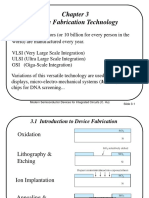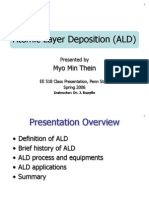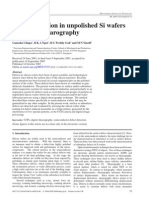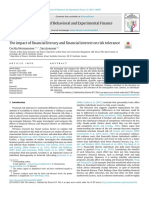Chapter 8 Ion Implantation - I
Chapter 8 Ion Implantation - I
Uploaded by
Kowshick GuruCopyright:
Available Formats
Chapter 8 Ion Implantation - I
Chapter 8 Ion Implantation - I
Uploaded by
Kowshick GuruOriginal Description:
Original Title
Copyright
Available Formats
Share this document
Did you find this document useful?
Is this content inappropriate?
Copyright:
Available Formats
Chapter 8 Ion Implantation - I
Chapter 8 Ion Implantation - I
Uploaded by
Kowshick GuruCopyright:
Available Formats
1. Introduction and application.
2. Ion implantation tools.
3. Dopant distribution.
4. Mask thickness and lateral distribution.
5. Effect of channeling.
6. Damage caused by ion implantation.
7. Damage repair.
Chapter 8 Ion implantation
1
NE 343: Microfabrication and thin film technology
Instructor: Bo Cui, ECE, University of Waterloo; http://ece.uwaterloo.ca/~bcui/
Textbook: Silicon VLSI Technology by Plummer, Deal and Griffin
A gas is ionized, and the ions are accelerated by a high electric field, and injected
into the target wafer to hundreds of nm depth.
Ion implantation and its history
Typical ion implantation parameters:
Ion: P, As, Sb, B, In, O
Dose: 10
11
- 10
18
cm
-2
Ion energy: 1 - 400 keV
Uniformity and reproducibility: 1%
Temperature: room temperature
Ion flux: 10
12
-10
14
cm
-2
s
-1
Dose (|) = # of atoms/cm
2
.
Concentration (C) = # of
atoms/cm
3
.
The idea was proposed by Shockley in 1954, but used for mass production only after
late 1970s.
Before ion implantation, doping is achieved by diffusion into the bulk silicon from
gaseous source above surface, or pre-deposited chemical source on wafer surface.
This approach lacks the flexibility and control required by CMOS processing, and ion
implantation quickly gained popularity for the introduction of dopant atoms.
Modern ion implanters were originally developed from particle accelerator technology.
Their energy range spans 100eV to several MeV (a few nms to several microns in depth
range). The implantation is always followed by a thermal activation (600-1100
o
C).
2
Advantages of ion implantation
Very precise dose control.
The ion implanter forms a simple electrical circuit. By monitoring the current in the circuit (or by a
monitoring circuit with Faraday cups), significant accuracy in the implanted dose can be maintained.
Assuming a current sensitivity of nA, and a minimum required implantation time of 10 seconds, it can
be shown that doses as low as 10
11
cm
-2
, can be measured.
On the contrary, in chemical source predeposits, dose values less than 510
13
/cm
2
are not achievable.
High dose introduction is not limited to solid solubility limit values.
Excellent doping uniformity is achieved across the wafer (< 1% variation across 12 wafer)
and from wafer to wafer.
Less dopant lateral diffusion, good for small device
(short channel).
Done in high vacuum, it is a very clean process step.
Besides precise dose control, one can also control
the profile (peak depth and spread range) better
than diffusion (peak concentration always near
surface).
(top) Doping by diffusion and drive-in.
(bottom) Doping by ion implantation with or without drive-in. 3
Advantages/disadvantage of ion implantation
Advantage:
Low-temperature process (can use photoresist as mask)
Wide selection of masking materials, e.g. photoresist, oxide, poly-Si, metal
Less sensitive to surface cleaning procedures.
Very fast (6" wafer can take as little as 6 seconds for a moderate dose)
Complex profiles can be achieved by multi-energy implants.
Disadvantage:
Very expensive equipment ( $1M or more).
At high dose values, throughput is less than diffusion (chemical source pre-
deposition on surface).
Ions damage the semiconductor lattice. Not all the damage can be corrected by
annealing.
Very shallow and very deep doping are difficult or impossible.
Masking materials can be knocked into the wafer creating unwanted impurities,
or even destroying the quality of the interface.
4
Application of ion implantation in CMOS fabrication
9-10 different implantations!
5
Dose-energy application space
6
Dose and energy
requirements of
major implantation
applications
(species shown
roughly in order of
decreasing usage).
SIMOX (Separation by IMplantation of OXygen) for SOI wafer
SOI wafers provide better performance for high speed circuits than conventional wafers.
SOI wafer by SIMOX has better yield, but more expensive than wafer bonding and CMP
process. (CMP = chemical mechanical polishing)
SIMOX depends on a peaked implant profile. Sharp interface are formed during annealing.
400nm buried oxide requires a high oxygen dose of 210
18
/cm
2
, which is a slow process.
SOI wafer =
silicon on insulator
7
SOI wafer by smart-cut using hydrogen implantation
1. H
+
ion implantation,
610
16
/cm
2
dose.
2. Direct wafer bonding.
3. Donor wafer cleavage
with heat treatment or
mechanical cleavage.
8
1. Introduction and application.
2. Ion implantation tools.
3. Dopant distribution.
4. Mask thickness and lateral distribution.
5. Effect of channeling.
6. Damage caused by ion implantation.
7. Damage repair.
Chapter 8 Ion implantation
NE 343: Microfabrication and Thin Film Technology
Instructor: Bo Cui, ECE, University of Waterloo, bcui@uwaterloo.ca
Textbook: Silicon VLSI Technology by Plummer, Deal, Griffin
9
Implantation equipment
Applied Materials Swift and Quantum series
IBS research implanter (pre-ship)
10
Schematic of an ion implanter
Ion source: operates at a high voltage(25kV) and convert the electrically neutral dopant
atoms in the gas phase into plasma ions and undesired species. Some sources: Arsine,
Phosphine, Diborane, Solid can be sputtered in special ion sources.
Mass spectrometer: a magnet bend the ion beam through right angle, and select the
desired impurity ion and purge undesired species. Selected ion passes through an aperture.
Accelerator: add energy to beam up to 5MeV. (contained, to shield possible x-ray).
Scanning system: x and y axis deflection plates are used to scan the beam across the wafer
to produce uniform implantation of desired dose. The beam is bended to prevent the
neutral particles from hitting the target .
11
Schematic of an ion implanter
12
Variable extraction voltage
(typically ~30KV )
Positive ions are attracted to the exit side of
the source chamber, which is biased at a large
negative potential with respect to the filament.
Plasma ion source and ion extraction
Filament emits electrons, which are accelerated to gain enough energy.
The electrons collide with the molecules or atoms, and ionize them.
The ions are extracted, rough-focused, then travel toward the magnetic analyzer.
(extraction)
13
Select implantation species
Only one mass will have exactly the
correct radius of curvature to exit the
source through the slit.
BF
3
gas spectrum
Dopant gas containing desired species, BF
3
,
BCl
3
, B
2
H
6
, PH
3
, AsH
3
, AsF
5
.
If using solid or liquid source, they need to
be heated to vaporize .
Plasma provides positive ions, (B
11
)
+
, BF
2
+
,
(P
31
)
+
, (P
31
)
++
.
14
Analyzing magnet
An analyzer magnet bends the ion beam through a right angle to select the desired species.
The equation of forces:
The radius R:
Mass to charge ratio of the selected ions: M/q = R
2
B
2
/ (2 V
ext
)
The displacement D: (should be 2/R, not 1/2R)
By adjusting the magnetic field, only selected
ions will enter the accelerating column.
15
Example : Mass Resolution
16
Final kinetic energy of the ion =
Q ( V
ext
+ V
acc
)
Example: V
ext
= 30KV, V
acc
= 70KV
Energy of the ion = 100 keV
Ion acceleration
This shows 14 equal acceleration
plates.
For example, if the desired
acceleration is 70keV, each section
would contribute 5k volts.
17
There may be ions that collided with other ions in the beam, undergoing a charge exchange.
Neutrals are highly undesirable since they will not be deflected in electrostatic end-station
scanning mechanisms.
To avoid this problem, most systems are equipped with a bend, i.e. parallel plates of an
electrostatic deflection system.
Neutrals are not deflected and so do not follow the beam, but instead strike a beam stop.
The ions are sufficiently deflected by the plates to continue to travel down the tube.
Neutral trap
18
Electrostatic scanning: low/medium
beam current implanters, I < 1mA.
This type of implanter is suitable for low dose implants.
The beam current is adjusted to result in t > 10 sec/wafer.
With scan frequencies in the 100 Hz range, good implant
uniformity is achieved with reasonable throughput.
Scan Patterns
Beam scanning
The focused ion beam is
scanned over the wafer in a
highly controlled manner in
order to achieve uniform
doping.
19
Excellent wafer cooling needed.
Substantial load/unload time.
15 - 25 wafers /disc.
Excellent throughput for high dose implants.
High current (~20mA)
Scan speed adjustment to insure uniform dose.
Mechanical scanning
Multi-wafer, mechanical
scanning end-station
Rotating disk, 1000rpm (rotations per minute).
Stationary ion beam, beam diameter ~5cm.
Eaton HE3 High Energy Implanter, showing the
ion beam hitting the 300mm wafer end-station.
20
Practical implantation dosimetry (dose measurement)
The implant dose | is the number of ions implanted per unit area (cm
2
) of the wafer.
If a beam current I is scanned for a time t , the total implanted charge Q = ( I x t ).
21
1. Introduction and application.
2. Ion implantation tools.
3. Dopant distribution profile.
4. Mask thickness and lateral distribution.
5. Effect of channeling.
6. Damage caused by ion implantation.
7. Damage repair.
Chapter 8 Ion implantation
NE 343: Microfabrication and Thin Film Technology
Instructor: Bo Cui, ECE, University of Waterloo, bcui@uwaterloo.ca
Textbook: Silicon VLSI Technology by Plummer, Deal, Griffin
22
Gaussian distribution for first order
approximation.
R
p
= projected range, is a function of ion
energy and mass, and atomic number
of impurity as well as target material.
AR
p
= straggle = standard deviation.
N
p
= peak concentration at x=R
p
.
Dose Q=}N(x)dx=(2t)
1/2
N
p
AR
p
.
In textbook, C is used for concentration, to
replace N used here.
Dopant (impurity) concentration profile
The impurity is shown implanted completely
below the wafer surface (x=0).
23
Projection range (depth) and
straggle (standard deviation)
M
i
and M
t
are the masses for
incident and target ion.
24
Example
25
Junction depth in Si
Junction formation by impurity
implantation. Two pn junctions are
formed at x
j1
and x
j2
.
( )
( )
( )
( )
B
p
p p j
p
p j
B
p
R
R x
p
B
B
R
R x
p
N
N
R R x
R
R x
N
N
e
N
N
N e N x N
p
p j
p
p j
ln 2
2
ln
2
2
2
2
2
2
2
2
A =
A
=
=
= =
A
Implant into Si already doped at N
B
.
E.g. implant P into B-doped Si.
P: n-type doping; B: p-type.
26
Example calculations
27
In many application doping profiles other than
the simple Gaussian are required.
Composite doping profile using multiples implants.
28
( )
|
|
.
|
\
|
=
Dt
x
Dt
Q
t x C
4
exp
2
,
2
t
( )
(
(
|
|
.
|
\
|
A
A
=
2
2
exp
2
p
p
p
R
R x
R
Q
x C
t
0 0
2
2
) (
t D
R
p
=
A
( )
( )
( )
( )
(
+ A
+ A
=
Dt R
R x
Dt R
Q
t x C
P
P
P
2 2
exp
2 2
,
2
2
2
t
Dt
D
0
t
0
Dt
Diffusion during subsequent anneals
During high temperature steps after implant (most commonly an activation anneal),
the implanted impurities will begin to diffuse, broadening the implantation profile.
For implantations far away from the surface and for reasonable short characteristic
diffusion lengths, the new profile can be approximated by:
29
Light ions such as B experience a relatively large amount of backward scattering and fill
in the distribution on the front side of the peak.
Heavy atoms such as antimony, experience a large amount of forward scattering and
tend to fill in the profile on the substrate side of the peak.
This asymmetry is usually expressed in terms of the skewness moment.
The different skewness can be visualized by thinking of forward momentum.
A more accurate distribution can be obtained by including kurtosis distribution.
A number of model has been proposed to explain this behavior. The most common one
is known as Pearson type IV (complicated).
Real impurity distribution
Boron Implanted into Silicon
30
Moments description
31
Ion implantation: Pearson IV profile
Measured boron impurity distributions compared with four moments
(i.e. Pearson IV) distribution functions.
The boron was implanted into amorphous silicon without annealing.
Very good curve fitting.
32
1. Introduction and application.
2. Ion implantation tools.
3. Dopant distribution profile.
4. Mask thickness and lateral distribution.
5. Effect of channeling.
6. Damage caused by ion implantation.
7. Damage repair.
Chapter 8 Ion implantation
NE 343: Microfabrication and Thin Film Technology
Instructor: Bo Cui, ECE, University of Waterloo, bcui@uwaterloo.ca
Textbook: Silicon VLSI Technology by Plummer, Deal, Griffin
33
Masking implants
Implant only certain part of the wafer:
Use a mask such that its R
p
lies within the mask material.
Used to form self-aligned source and drain region (masked by gate) in MOSFET.
(lateral spreading of dopant)
34
* *
*
* *
ln 2
P P
B
P
P P m
R m R
C
C
R R x A + =
|
|
.
|
\
|
A + =
Mask Si In order to act as an efficient mask, the thickness
of the mask should be large enough that the tail of
the implant profile in the silicon should not
significantly alter the doping concentration (C
B
).
How thick mask is needed?
( )
B
m
P m
C
R
R x
C x C
P
P
s
(
(
=
2
*
2
*
*
2
exp ) ( *
(* means for value in the mask layer)
|
|
.
|
\
|
A
=
(
(
|
|
.
|
\
|
A
A
=
}
*
*
2
*
*
*
2
erfc
2 2
1
exp
2
p
P m
x
p
P
p
P
R
R x Q
dx
R
R x
R
Q
Q
m
t
Mask thickness x
m
Dose penetrating the mask:
Rule of thumb: good masking thickness
X
m
= R
p
+ 4.3AR
p
, C(x=X
m
)/C(x=R
p
) ~ 10
-4
.
35
36
Photoresist is commonly used as implant mask.
Resist may flow or be baked to such an extent that it is difficult to remove after implant.
Outgassing: ions striking resist surface break apart the organic molecules in resist, leading to
formation of gaseous H
2
that evolves from resist surface, leaving behind involatile carbon.
Heavily implanted resist layers often have a hardened carbonized layer near surface difficult
to remove later on.
The outgassing can raise the pressure in the end station sufficiently to cause neutralization of
ion beam through impact with the H
2
molecules, resulting in significant dose rate errors.
Mask material: resist
Resist damage at high implant currents
BF
2
+
implant at 80A in Varian 400
without a water cooled chuck
(water cool can reduce the problem)
37
Mask material thickness
38
Lateral scattering
(
(
|
|
.
|
\
|
A
A
=
2
2
1
exp
2
) (
) , (
R
y
R
x C
y x C
t
The implanted ion also scatter laterally
around the impact point, which can also
be approximated by Gaussian distribution
with transverse straggle R
T
.
39
A 2-D formulation of implantation profile
Monte Carlo simulation of many ions into Si
40
You might also like
- Plasma RIE Etching Fundamentals and ApplicationsNo ratings yetPlasma RIE Etching Fundamentals and Applications59 pages
- Crystal Growth and Wafer FabCrystal Growth and Wafer FabricationricationNo ratings yetCrystal Growth and Wafer FabCrystal Growth and Wafer Fabricationrication16 pages
- Chapter 3 Crystal Growth, Wafer Fabrication and Basic Properties of Silicon WafersNo ratings yetChapter 3 Crystal Growth, Wafer Fabrication and Basic Properties of Silicon Wafers40 pages
- Atomic Layer Deposition (ALD) : Myo Min TheinNo ratings yetAtomic Layer Deposition (ALD) : Myo Min Thein28 pages
- Introduction To The Course: EE669: VLSI TechnologyNo ratings yetIntroduction To The Course: EE669: VLSI Technology20 pages
- Laser Writer - Overview of Different Process Steps at IISc CeNSENo ratings yetLaser Writer - Overview of Different Process Steps at IISc CeNSE14 pages
- Dye Sensitized Solar Cells PresentationNo ratings yetDye Sensitized Solar Cells Presentation20 pages
- CMOS Processing Technology Silicon: A Semiconductor With Resistance Between That of Conductor and AnNo ratings yetCMOS Processing Technology Silicon: A Semiconductor With Resistance Between That of Conductor and An18 pages
- Lot To Lot Wafer To Wafer Die To Die: Process VariationsNo ratings yetLot To Lot Wafer To Wafer Die To Die: Process Variations8 pages
- SU-8 A Photoresist For High-Aspect-Ratio and 3D Submicron LithographyNo ratings yetSU-8 A Photoresist For High-Aspect-Ratio and 3D Submicron Lithography16 pages
- Introduction To Integrated Circuit TechnologyNo ratings yetIntroduction To Integrated Circuit Technology45 pages
- 4th Lecture Thin Films Deposition MethodsNo ratings yet4th Lecture Thin Films Deposition Methods32 pages
- PHD Thesis - Dalong Zhao-ZnO TFT Thin Film Passivation - Noise Analysis, Hooge ParameterNo ratings yetPHD Thesis - Dalong Zhao-ZnO TFT Thin Film Passivation - Noise Analysis, Hooge Parameter169 pages
- Sputtering: The Removal of Surface Atoms Due To Energetic Particle Bombardment100% (1)Sputtering: The Removal of Surface Atoms Due To Energetic Particle Bombardment27 pages
- Course Title: VLSI Technology Course No.: EEE 489No ratings yetCourse Title: VLSI Technology Course No.: EEE 48925 pages
- X-Ray Absorption and X-Ray Emission Spectroscopy: Theory and ApplicationsFrom EverandX-Ray Absorption and X-Ray Emission Spectroscopy: Theory and ApplicationsNo ratings yet
- Journal of Behavioral and Experimental Finance: Cecilia Hermansson, Sara JonssonNo ratings yetJournal of Behavioral and Experimental Finance: Cecilia Hermansson, Sara Jonsson12 pages
- The 20 SUN SEALS and Their Directional Associations Mayan FactorNo ratings yetThe 20 SUN SEALS and Their Directional Associations Mayan Factor4 pages
- An Overview of Fingerprinting and Presumptive Blood Testing: GEK1542 ReportNo ratings yetAn Overview of Fingerprinting and Presumptive Blood Testing: GEK1542 Report21 pages
- Reflective Report and Action Plan - EditedNo ratings yetReflective Report and Action Plan - Edited12 pages
- USE US Operation Manual DHR US en 2020 RNo ratings yetUSE US Operation Manual DHR US en 2020 R42 pages
- Queer Theory in Education William F.Pinar (2009)No ratings yetQueer Theory in Education William F.Pinar (2009)351 pages
- Ohm's Law and Series and Parallel Connections Activity Sheet - 1200No ratings yetOhm's Law and Series and Parallel Connections Activity Sheet - 12008 pages
- Crystal Growth and Wafer FabCrystal Growth and Wafer FabricationricationCrystal Growth and Wafer FabCrystal Growth and Wafer Fabricationrication
- Chapter 3 Crystal Growth, Wafer Fabrication and Basic Properties of Silicon WafersChapter 3 Crystal Growth, Wafer Fabrication and Basic Properties of Silicon Wafers
- Introduction To The Course: EE669: VLSI TechnologyIntroduction To The Course: EE669: VLSI Technology
- Laser Writer - Overview of Different Process Steps at IISc CeNSELaser Writer - Overview of Different Process Steps at IISc CeNSE
- CMOS Processing Technology Silicon: A Semiconductor With Resistance Between That of Conductor and AnCMOS Processing Technology Silicon: A Semiconductor With Resistance Between That of Conductor and An
- Lot To Lot Wafer To Wafer Die To Die: Process VariationsLot To Lot Wafer To Wafer Die To Die: Process Variations
- SU-8 A Photoresist For High-Aspect-Ratio and 3D Submicron LithographySU-8 A Photoresist For High-Aspect-Ratio and 3D Submicron Lithography
- PHD Thesis - Dalong Zhao-ZnO TFT Thin Film Passivation - Noise Analysis, Hooge ParameterPHD Thesis - Dalong Zhao-ZnO TFT Thin Film Passivation - Noise Analysis, Hooge Parameter
- Sputtering: The Removal of Surface Atoms Due To Energetic Particle BombardmentSputtering: The Removal of Surface Atoms Due To Energetic Particle Bombardment
- Ferroelectric and Antiferroelectric Liquid CrystalsFrom EverandFerroelectric and Antiferroelectric Liquid Crystals
- X-Ray Absorption and X-Ray Emission Spectroscopy: Theory and ApplicationsFrom EverandX-Ray Absorption and X-Ray Emission Spectroscopy: Theory and Applications
- Journal of Behavioral and Experimental Finance: Cecilia Hermansson, Sara JonssonJournal of Behavioral and Experimental Finance: Cecilia Hermansson, Sara Jonsson
- The 20 SUN SEALS and Their Directional Associations Mayan FactorThe 20 SUN SEALS and Their Directional Associations Mayan Factor
- An Overview of Fingerprinting and Presumptive Blood Testing: GEK1542 ReportAn Overview of Fingerprinting and Presumptive Blood Testing: GEK1542 Report
- Ohm's Law and Series and Parallel Connections Activity Sheet - 1200Ohm's Law and Series and Parallel Connections Activity Sheet - 1200

























































































